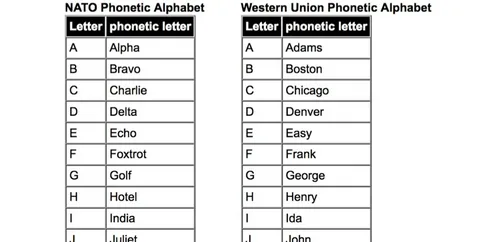Table of Contents
ToggleWhat is the Phonetic Alphabet?

The phonetic alphabet is a system that assigns specific words to letters of the alphabet. Instead of saying “B as in boy,” you would say “B as in Bravo.” This method enhances clarity and reduces misunderstandings, especially in noisy environments or over poor-quality audio connections.
In Australia, the phonetic alphabet primarily follows the International Civil Aviation Organization (ICAO) standard. This system is recognized worldwide, allowing Australians to communicate effectively with people from different countries and professions.
Why is the Phonetic Alphabet Important?
- Clarity in Communication: The phonetic alphabet eliminates confusion over letters that sound alike. For example, “B” and “D” can easily be misheard.
- Global Standardization: By using a universally recognized phonetic alphabet, Australians can communicate seamlessly with others, no matter where they are in the world.
- Efficiency: This method speeds up communication, particularly in situations where time is critical, such as in emergency services or aviation.
- Safety First: In high-stakes environments, clear communication can make the difference between life and death. The phonetic alphabet ensures that messages are conveyed accurately.
The Phonetic Alphabet Used in Australia
Here’s the phonetic alphabet used in Australia, which aligns with the ICAO standard:
- A – Alpha
- B – Bravo
- C – Charlie
- D – Delta
- E – Echo
- F – Foxtrot
- G – Golf
- H – Hotel
- I – India
- J – Juliett
- K – Kilo
- L – Lima
- M – Mike
- N – November
- O – Oscar
- P – Papa
- Q – Quebec
- R – Romeo
- S – Sierra
- T – Tango
- U – Uniform
- V – Victor
- W – Whiskey
- X – X-ray
- Y – Yankee
- Z – Zulu
This phonetic alphabet helps in spelling out names, places, and codes in a way that’s easily understood.
Everyday Usage of the Phonetic Alphabet

Imagine you’re booking a flight in Australia. The airline representative asks for your last name. Instead of spelling it letter by letter, you might say, “That’s S as in Sierra, M as in Mike, I as in India, T as in Tango, H as in Hotel.” This method streamlines the conversation and ensures there’s no confusion.
Another example: During an emergency call, a firefighter might need to communicate vital information quickly. Using the phonetic alphabet can save precious seconds and ensure that every letter is heard correctly.
The Benefits of Learning the Phonetic Alphabet
So, why should you invest time in learning the phonetic alphabet in Australia Here are a few reasons that stand out:
- Enhanced Communication Skills: Mastering the phonetic alphabet helps you express yourself more clearly, particularly in professional settings.
- Boosted Confidence: When you’re confident in your communication skills, it shows. You’ll feel more at ease when speaking on the phone or in public.
- Versatile Application: From making reservations to conducting business, the phonetic alphabet can come in handy in a multitude of scenarios.
- Fun and Engaging: Learning the phonetic alphabet can be a fun challenge. It’s like mastering a new skill or language!
FAQs About the Phonetic Alphabet in Australia
What is the main purpose of the phonetic alphabet?
The primary purpose of the phonetic alphabet is to ensure clear and precise communication, particularly when spelling words over the phone or in noisy environments.
Is the phonetic alphabet used globally?
Yes, the phonetic alphabet is used worldwide, with variations in some countries. However, the ICAO version is widely accepted and understood.
Can I use the phonetic alphabet in casual conversations?
Absolutely! While it’s often used in professional settings, you can incorporate it into everyday life to enhance clarity and reduce misunderstandings.
How can I memorize the phonetic alphabet?
One effective way to memorize it is to create visual associations with each word. For instance, picture an “Alpha” wolf when thinking of the letter “A.”
Mastering the Phonetic Alphabet in Australia
As Australians, it’s essential to understand and use the phonetic alphabet effectively. Here’s how you can get started:
1. Familiarize Yourself with the Words
Start by learning the words associated with each letter. You can create flashcards or use apps that focus on phonetic spelling.
2. Practice in Real Situations
Try using the phonetic alphabet in daily interactions. Spell out your name, address, or any other relevant information while making calls.
3. Engage with Others
Practice with friends or family. Challenge each other to spell out words using the phonetic alphabet. This can be a fun and interactive way to reinforce your learning.
4. Listen and Repeat
Watch videos or listen to audio resources that demonstrate the phonetic alphabet in use. Repetition is key to retention.
5. Stay Consistent
Make it a habit. The more you use the phonetic alphabet, the more natural it will become.
Conclusion: The Importance of the Phonetic Alphabet in Australia
The phonetic alphabet is more than just a list of words; it’s a vital tool for effective communication in Australia. From everyday conversations to critical situations, understanding and using the phonetic alphabet enhances clarity and reduces the risk of misunderstandings.
Next time you find yourself needing to spell something out, remember the phonetic alphabet. It’s a simple yet effective way to ensure your message is understood clearly.
By embracing this tool, you’ll enhance not just your communication skills, but also your confidence in various settings. So, go ahead and dive into the world of the phonetic alphabet in Australia—your conversations will thank you for it!

